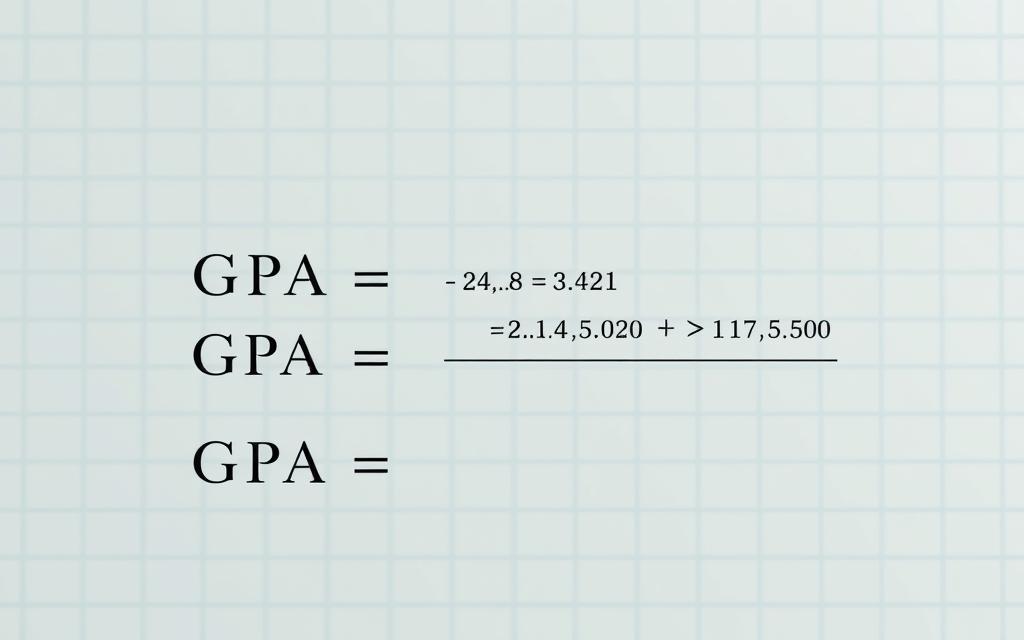Step-by-Step Guide to Calculating Cumulative Grades
Your cumulative grade point average (GPA) is vital for tracking academic success. It offers a standardised measure of your scholarly achievements. This numerical score, typically on a 0-4.0 scale, helps assess your academic potential.
Cumulative GPA reflects grades from all courses throughout your educational journey. It provides a complete view of your performance across multiple terms. This score is crucial for determining eligibility for various academic opportunities.
A strong GPA can open doors to prestigious institutions. It’s key for college admissions, scholarship applications, and future career prospects. Understanding its impact is essential for students aiming to maximise their academic standing.
Calculating cumulative GPA involves considering course grades and credit hours. Each letter grade corresponds to a specific point value. An A typically represents the highest achievable score of 4.01.
Understanding Cumulative GPA and Its Significance
Cumulative GPA is a vital measure of a student’s overall academic performance. It tracks scholastic success throughout a student’s entire educational journey. This key indicator is crucial for assessing academic achievement2.
Cumulative GPA uses a standardised scale, typically from 0 to 4.0. A 4.0 score represents the highest possible achievement2. Students can achieve two main types of GPAs:
- Unweighted GPA: A standard calculation method using a consistent 4.0 scale
- Weighted GPA: Allows additional points for advanced or challenging courses3
What Defines a Cumulative Grade Point Average
Cumulative GPA averages all grades earned throughout a student’s academic career. It offers a comprehensive overview of academic performance2. Top universities often expect GPAs above 3.5 when evaluating student applications2.
Why Cumulative GPA Matters
Academic achievement through cumulative GPA impacts various opportunities:
- College admissions
- Scholarship eligibility
- Future employment prospects
Different Types of GPA Calculations
Weighted and unweighted GPAs have important differences. Weighted GPAs can exceed the standard 4.0 scale, reaching up to 5.0 for advanced courses2.
Some scholarship programmes require maintaining a minimum 3.0 GPA. This ensures continued financial support for students2.
Your cumulative GPA is more than just a number—it’s a reflection of your academic dedication and potential.
The Fundamentals of GPA Calculation System
Grasping the GPA calculation system is vital for academic success. Most schools use a standardised grade points method to assess students4. The typical grading scale uses a 4.0 system, matching letter grades to numerical values5.

- Letter grades are converted to numerical grade points
- Each course is assigned credit hours
- Performance is evaluated across multiple academic terms
The standard grade point scale breaks down as follows:
| Letter Grade | Grade Points |
|---|---|
| A | 4.0 |
| A- | 3.7 |
| B+ | 3.3 |
| B | 3.0 |
Some schools offer a weighted GPA scale for advanced courses4. For example, a B in an AP course might earn 3.3 points instead of 3.04.
Credit hours are crucial in calculating your overall academic performance. Courses with varying credit weights affect your cumulative GPA differently6.
How to Compute Cumulative Grading System
GPA calculation requires tracking academic performance systematically. Students need a method to convert their achievements into standardised numerical values7.
Cumulative average computation transforms letter grades into numerical values. Each grade gets a specific point value. This enables precise tracking of academic progress8.
Essential Components for Calculation
Key elements in GPA calculation include:
- Individual course grades
- Credit hours for each course
- Institutional grading scale
Converting Letter Grades to Numerical Values
Most educational systems use a standardised approach for numerical conversions. United States school systems use this numeric scale9:
- “A” = 4 points
- “B” = 3 points
- “C” = 2 points
- “D” = 1 point
- “F” = 0 points
Mathematical Formula for GPA Computation
The core formula involves multiplying each course grade by its credit hours. Then, divide the total grade points by total credit hours9. Precision is paramount in this calculation.
Let’s look at an example. A student earns 12, 3, and 6 grade points across 7 total credit hours. Their GPA would be 21 ÷ 7 = 3.09.
Weighted vs Unweighted GPA Explained
Grasping the difference between weighted and unweighted GPAs is vital for students. Unweighted GPAs use a standard 4.0 scale. Every grade holds equal value, regardless of course difficulty.
Weighted GPAs offer a broader view of academic achievement. They recognise the challenge of honours and advanced placement courses. Students tackling harder subjects can earn GPAs above 4.0, up to 5.0.
- Unweighted GPA maximum: 4.0
- Weighted GPA maximum: 5.0
- Additional grade points for advanced courses
Universities often look at both GPA types during admissions. Top schools like Ivy Leagues typically seek unweighted GPAs of 3.9 or higher. A comprehensive GPA comparison can provide more insight.
Pro tip: GPA isn’t everything. Admissions officers also value course difficulty. A 3.7 from challenging courses may outshine a 4.0 from standard classes.
Academic excellence isn’t just about numbers—it’s about intellectual growth and challenge.
Common Mistakes in GPA Calculations
GPA calculations can be tricky for students aiming for academic accuracy. Knowing common errors is vital for keeping your academic record correct. Mistakes often occur due to subtle differences in grade point computations10.
Credit hour tracking is a frequent challenge in GPA accuracy. Students might miscalculate by not properly accounting for different course credit weights. Some classes have 3 credits, while others may have different credit assignments11.
Grade point errors often come from inconsistent grading scales. Schools may use different point systems for letter grades. This can lead to significant discrepancies10.
Subtle differences between grade point values require careful attention. For example, a B+ might equal 3.3 points, while a B- equals 2.7 points11.
Rounding practices can also cause GPA calculation mistakes. Some unis round to the nearest tenth, others to the nearest hundredth. These small differences can affect your academic record and future opportunities10.
FAQ
What exactly is a Cumulative Grade Point Average (GPA)?
How is Cumulative GPA different from Term GPA?
Why is Cumulative GPA so important?
What is the difference between weighted and unweighted GPAs?
How are letter grades converted to numerical values?
How do credit hours impact GPA calculation?
What are common mistakes in GPA calculations?
Can students improve their Cumulative GPA?
How often should students calculate their Cumulative GPA?
Do all universities use the same GPA calculation method?
Source Links
- https://ambitio.club/blog/calculate-your-cumulative-gpa/
- https://www.timeshighereducation.com/student/advice/what-gpa
- https://blog.collegevine.com/what-is-cumulative-gpa
- https://www.princetonreview.com/college-advice/gpa-college-admissions
- https://ask.salemstate.edu/kb/how-calculate-grade-point-average-gpa
- https://www.mun.ca/regoff/records/grades-averages-and-gpa/grade-point-average-gpa/
- https://gwacalculator.ph/cumulative-grading-system/
- https://ambitio.club/blog/cgpa/
- https://www.sciencing.com/calculate-cumulative-numerical-average-7738613/
- https://yocket.com/us/blog/cumulative-gpa
- https://www.collegeraptor.com/getting-in/articles/college-applications/how-to-calculate-cumulative-gpa/













